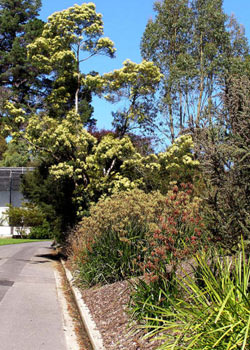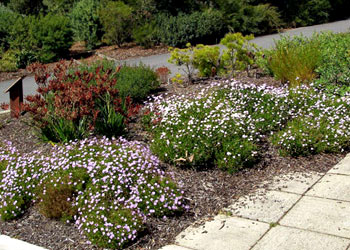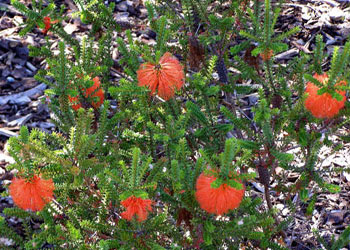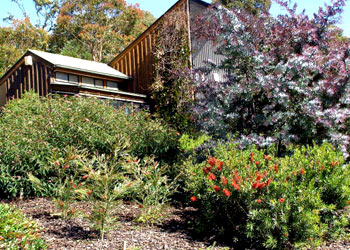
The Dunedin Botanic Garden and its Australian Section
Tony Cavanagh
Most of us probably know that Dunedin is a city on the east coast of the south island of New Zealand. However, what we don't generally realise is just how far south Dunedin actually is. In fact, the latitude of Dunedin is below that of South East Cape, the most southerly point of Tasmania! So why on earth would anyone try to grow Australian plants in open gardens here?
 |
|
Kangaroo paws and Acacia mearnsii
in flower
Photo: Tony Cavanagh |
| |
We recently spent several days in this delightful area of New Zealand. Dunedin is a city of over 120,000 people, famed for its numerous Victorian buildings, the oldest University in New Zealand with over 26,000 students and a vibrant social and cultural life. It is also the jumping-off point for the wild and beautiful Catlins coast and the Otago Peninsula with its world-famous Royal Albatross colony. Less well known is its Botanic Garden, the oldest in New Zealand, which was established on its present site of 28 hectares in 1868. We were lucky with the weather, a perfect autumn day with sun and blue skies and we spent five hours wandering around on deep, lush green lawns (no water problems here) and through the many collections. Imagine our astonishment when near the aviaries, we came across a whole area devoted to Australian plants.
The Dunedin Botanic Garden is on a hill and has both upper and lower gardens. In many ways, it follows the traditions of European Botanic Gardens with large collections of "exotics" such as rhododendrons, a Cherry Walk, a Winter Garden Conservatory, floral borders and beds of annuals, a Rose garden, herb gardens and "added extras" such as fountains, whimsical statues of Peter Pan, a water garden, bird aviaries and a Band Rotunda which is still used for summer concerts. As early as 1905, the curator, David Tannock, conceived the idea of Geographical Collections which were to display plants from around the world. The first Australian plants in the gardens date from this period. In recent years, the Geographical Collections have been expanded to include a large collection of New Zealand native plants and a New Zealand bush area. As we wandered around, we discovered extensive plantings of Southern African (including desert areas), Asian and some South American species, all very healthy with many flowering.
But the gem for us was the Australian area which was located near the bird aviaries. We had already seen a Eucalyptus Arboretum and several very large gums which we took to be Tasmania blue gums. The gardens were immaculately maintained and a lot of species were in full flower.
 |
 |
Left: Brachyscomes and kangaroo paws. Right: Very healthy gum trees
Photos: Tony Cavanagh |
First to catch our eye were large clumps of Anigozanthos flavida (Kangaroo Paw) hybrids and at the end of a garden, a large Acacia mearnsii in full flower. Then, the biggest shock of all, plants of the very uncommon Western Australian Beaufortia sparsa in full flower. I have only ever seen this once in Victorian gardens and I wondered who on earth would have thought that this plant from swampy land in Western Australia would survive in the Dunedin climate! Further around was a large flowering Crowea ?saligna, and Boronia megastigma and Boronia heterophylla. A low cottage garden was filled with various colour forms of Brachycombe multifida and plants of dwarf kangaroo paw. There were also a number of grevilleas, with Grevillea 'Superb' in full flower, several bottlebrushes and the purple form of Acacia baileyana (Cootamundra wattle). Lomandras were commonly used in clump plantings and other plants also claimed to be grown but not seen by us include Callitris, Prostanthera, Dianella and Leptospermum, and the climbers Kennedia, Clematis and Pandorea.
 |
 |
Left: Beaufortia sparsa - a complete surprise! Right: The tall shrubs - Callistemon and
purple Cootamundra wattle
Photos: Tony Cavanagh |
New Zealand does share some plants with us including species of the genera Pittosporum, Leptospermum, Nothofagus and Celmisia, to name just some. To me, some of the prettiest New Zealand plants are their Hebes of which there are apparently over 100 species and many wonderful garden cultivars. The Dunedin Botanic Garden is a great place to see flowers from all over the world and the greatest surprise to see so many Australian plants doing so well in what must be a hostile climate in the winter. I would rank it as nearly the best Botanic Garden I have ever seen and it is definitely worth a visit if you are ever in the area.
From the newsletter of the Geelong Group of the Australian Plants Society (Victoria)
Australian Plants online - 2009
Australian Native Plants Society (Australia)
|